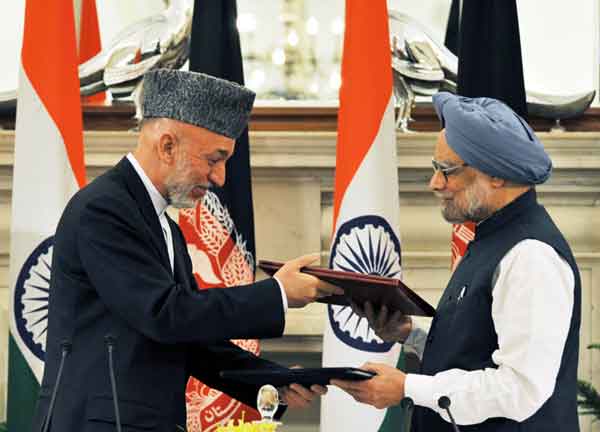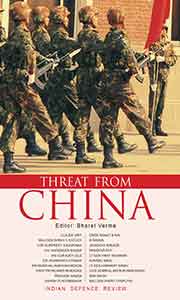
Prime Minister Manmohan Singh and the President of Afghanistan, Mr. Hamid Karzai exchanging the singed documents of an agreement on Strategic Partnership between the Republic of India and the Islamic Republic of Afghanistan
Prime Minister Manmohan Singh and President Hamid Karzai discussed the US-Afghanistan Bilateral Security Arrangement (BSA) when they met in New Delhi last month. The US withdrawal from Afghanistan in 2014 in the immediate aftermath of Presidential elections and rapid expansion of Afghan National Army undertaken only post 2014 does create a dilemma in respect of future stability of Afghanistan when seen in the backdrop of Taliban’s continuing rigid stance and Pakistan reportedly training scores of Mujahid battalions as irregulars and mating them with her proxies in order to increase her cross-border areas of influence once US forces depart, in pursuit of its cherished strategic depth; creating a succession of radicalised Islamic societies from the Indian-Pakistani border to Central Asia, giving the ISI the ability to create a clandestine empire composed of the likes of Haqqanis, Taliban and the LeT, as described by Robert H Kaplan in his book ‘The Revenge of Geography’.
A major problem with the ANA is that it is not a regular army, with soldiers on three year contractual basis. This creates apparent future insecurity in their minds especially towards the end of the contractual period.
The India-Afghanistan strategic partnership is an important facet of bilateral cooperation between the two nations, of which security is an important segment. Afghanistan has reportedly asked for military assistance in terms of tanks, mortars, artillery and aircraft besides military vehicles like troop carrying trucks, jeeps etc. Afghanistan has also sought a training facility in Afghanistan to train its officers and soldiers, in addition to assistance in maintenance of military equipment. It is but axiomatic that India would provide all possible assistance under the India-Afghanistan strategic partnership. 100 officers of Afghan National Army (ANA) will be trained for four weeks at the Counter Insurgency and Jungle Warfare School (CIJWS) located at Vairangte in Mizoram.
Maintenance and repair of military equipment will be a major problem post the US withdrawal. It is at a premium even now. As per a report released in January 2013 by the Centre for Strategic and International Studies (USA), the US direct spending for war in Afghanistan from 2002 to 2013 totaled $641.7 billion (bulk after 2009), of which $198.2 billion (over 30%) was spent in FY2012 and FY2013. Though vast majority of aid went to Afghan National Security Forces (ANSF), little was done to establish repair and maintenance facilities. The US had purchased Mi-17 helicopters from Russia and supplied these to Afghanistan. The US and NATO are presently in talks for establishing Russian repair facilities for these helicopters in Afghanistan.
Since Afghanistan has asked India to also establish base repair facilities in Afghanistan, it would be prudent to optimise the India-Russia defence partnership to jointly cater for repair and maintenance of most military equipment that Afghanistan would have in 2014 and beyond. To this end, President Karzai has welcomed setting up of a joint India-Russia repair and maintenance facility in Afghanistan that has been agreed to. Afghanistan already holds military equipment with origins in some 30 countries. To add to this would be equipment that the US forces are likely give to Afghan Security Forces, one example being UAVs. In fact, it would be prudent for the US to leave behind technical staff for repair and maintenance of the US origin equipment under the BSA for a couple of years, till requisite capacity is built up within Afghan forces. Convergence of US-Russia interests should facilitate such arrangement as both countries do not want Taliban influence seeping into Central Asia and Eurasia post US withdrawal.
This force should have the capacity to ward off terrorist attacks. India can help Afghanistan in creating such a force.
Afghanistan is home to some $3 trillion worth untapped mineral deposits. If this is exploited in a secure and safe environment, it could yield an annual revenue of $1.2 billion after five years and $3.5 billion after 15 years. Then there are some 3.8 billion barrels of oil between Balkh and Jazwan alone while Afghanistan only consumes 5,000 bbl per day. Estimated mean volumes of undiscovered petroleum were 1,596 million barrels (Mbbl) of crude oil, 444 billion cubic meters of natural gas, and 562 Mbbl of natural gas liquids. In Dec 2011, Afghanistan signed an oil exploration contract with China National petroleum Corporation (CNPC) for development of three oil fields along the Amu Darya. CNPC began Afghan oil production in October 2012, extracting 1.5 million barrels of oil annually. With oil hovering around $100 a barrel, an output of 250,000 bpd would earn Afghanistan about $9.1 billion a year. That would be roughly half the country’s gross domestic product of $20 billion in 2011, according to the World Bank.The catch in all this is having a secure environment especially since no foreign venture is permitted to bring its own security forces along. What Afghanistan therefore needs is a strong Central Industrial Security Force (CISF) that can protect all the civil ventures including mineral, petroleum and gas exploration, as also provide protection to repair and maintenance facilities that are to be established. This force should have the capacity to ward off terrorist attacks. India can help Afghanistan in creating such a force.
A major problem with the ANA is that it is not a regular army, with soldiers on three year contractual basis. This creates apparent future insecurity in their minds especially towards the end of the contractual period. Therefore, the desertion rates are very high. John Glaser writing in AntiWar.com on 18 December 2012 reported around 50,000 Afghan soldiers (26 percent ANA), quitting each year, and additionally, about 8 percent of Afghan police officers quit each year. Though a regular army is highly desirable, Afghanistan is perhaps unable to do so because of the poor and uncertain economic conditions. The Tokyo Mutual Accountability Framework was adopted at the Tokyo Conference on Afghanistan in Japan on July 8, 2012. Among the international community’s provisions in the framework, it committed to provide over $16 billion through 2015, and sustaining support, through 2017, at or near levels of the past decade to respond to the fiscal gap as estimated by the World Bank and the Afghan Government. Then in March 2013,NATO decision on supporting the retention of the 350,000-strong ANSF up to 2018 implied that $3.6 billion in annual assistance pledged at the Chicago Summit would now be raised to $5.6 billion, at least until 2018.
What Afghanistan needs from the world is continued financial support for converting the ANSF to a regular force, till the time Afghanistan’s own economy can come up to sustain these forces indigenously. That would be a significant contribution for the security and stability of the region.






India has 2 options to counter Pakistan in Afghanistan. Either India has to deploy its own troops & arm the Afghanistan National Army & Afghanistan Air Force, so that they can jointly counter Pakistan. This will ensure that the threat from Taliban is neutralized within next few years. Alternatively it has to only arm the ANA & AAF. If India has to deploy troops, it needs to induct at least 4 corps (i.e. 12 divisions/180000 troops) in Afghanistan for a minimum period of 3-5 years to make a significant impact. This also requires massive air support, which means 10-15 squadrons (200-300 planes) of fighter jets and other air elements (transport planes and choppers, attack choppers, refuelling, AWACS, etc.). The second option is to only arm the ANA, through a combination of Indian weapons and weapons imported from other nations, but financed by India. The second option should also include few IAF figher jet squadrons & special forces to be deployed in Afghanistan to help the ANA & AAF. However, for both the options to succeed, RA&W needs to establish massive intelligence network not just in Afghanistan but also Pakistan, the country aiding and abetting the Taliban. Further, RA&W should reopen its covert operations wing, which was closed during Gujral’s administration. It should start covert operations in both Pakistan and Afghanistan to counter the terror and nuclear threat from Pakistan to both India and Afghanistan. Further, the covert operations capability should also be extended to other neighboring countries to counter other threats. However in the current security scenario faced by India, it is unlike that India can deploy massive number of troops in Afghanistan. Hence, the best option is to arm the ANA and AAF, along with placing few squadrons of fighter jets and special forces in Afghanistan. With withdrawal of majority of the US forces by 2014, the threat to both Afghanistan & India is growing. India should take actions proactively and secure it own interests.